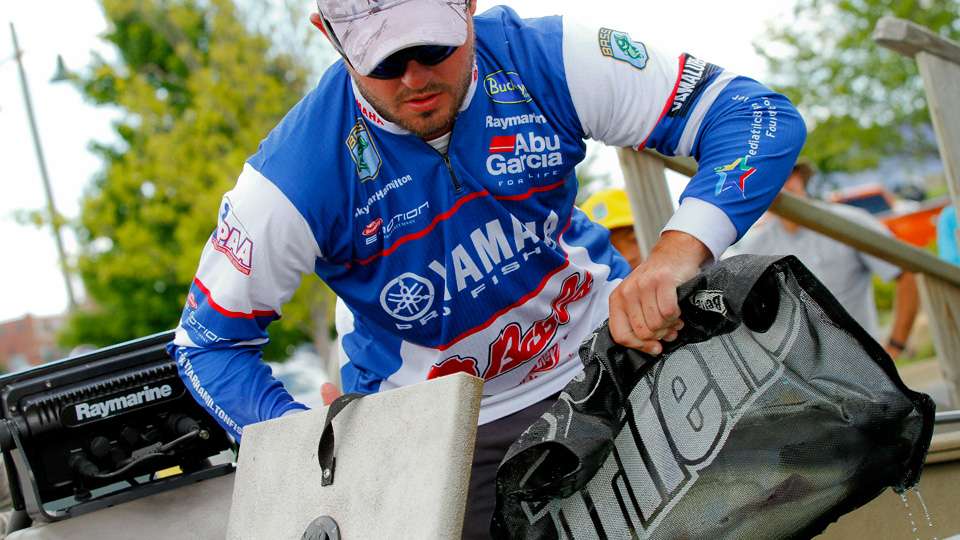
MUSKOGEE, Okla. — From Tennessee to Oklahoma aluminum boats are filling a tournament niche in skinny water where the big rigs can’t go. A couple weeks ago Ott DeFoe used his Tracker Boats modified Grizzly model for a Top 12 finish on Douglas Lake at the Bass Pro Shops Bassmaster Southern Open.
This week Skylar Hamilton fished from a customized Grizzly 1860SC to win at the Central Open on the Arkansas River.
Ironically, Hamilton and DeFoe share the same fabricator who works magic on the hulls to make them run slightly faster and a bit shallower than the stock boats. That’s a story for another time.
The timely story is Hamilton chose to bring the aluminum boat from Tennessee to Oklahoma for all the wrong reasons.
“I brought it here based on the thought the water would be low, too low for getting a fiberglass rig into the areas I wanted to fish,” said Hamilton, of Dandridge, Tenn.
Instead, the water was very much on the high side. Heavy rains the week prior to the tournament and during the competition created unusually high runoff. The Arkansas River went up 2 feet in the immediate area.
The decision wasn’t a bad idea after all. Hamilton forced himself to search for water inaccessible to the majority of the boats. Tapping into the boat’s clear advantages proved beneficial, low water or not.
Dodging boat-sized logs and floating debris was more challenging than finding water shallow enough to run the aluminum rig.
Hamilton’s boat runs on plane in water about 4 inches deep. The boat is rigged to run shallow but with a performance edge. A 70 horsepower Yamaha weighing around 257 pounds powers the rig. That’s substantially lighter than a comparable 90 horsepower motor for which the boat is rated.
“I’m more inclined to think cutting weight, as much as you can, is more critical a goal than anything else,” said Hamilton.
To that end he chose to lighten up on the shallow water anchor system, which is essential for using the rig in strong current. Power-Pole Micro Anchors weighing 7 1/2 pounds are his choice. Those are much lighter than the standard Power-Poles used in fiberglass rigs.
“They are easier to use and don’t have hydraulics,” he said. “I can also store them flush with the deck for improved clearance around low trees in the water.”
The fabricator added a 12-inch aluminum plate above the deck line for even more outboard extension. That gives the boat added clearance with the Atlas jack plate mounted to the transom.
Hamilton and DeFoe use the boats for the Opens but not other tournaments around their east Tennessee homes. One of the largest tournament organizers in the area banned tunnel hull boats. Jet-drive powered outboards are banned in B.A.S.S. competition.
To lock or not
Tournaments on rivers with lock and dam systems along the way pose a time management risk for the anglers.
The option of fishing more water, and sometimes more productive areas, is the reward for locking elsewhere on the river. The risk is getting stuck in a pool where you can’t get out. Being late can mean forfeiting a catch due to penalties.
On Day 3 that is what almost happened for Justin Margraves, a guide on Lake Fork, Texas, who finished sixth on the Arkansas River.
Margraves ventured into the Kerr pool in the hopes of improving his catch. By 11 a.m. he became worried about locking back to make a 2 p.m. check-in time.
“I called the lockmaster and he said there were two barges in line ahead of me,” said Margraves. “No way was I going to make it through there, he told me.”
“It’s just a sick feeling knowing you’ve got a limit in the livewell and no way to get back,” he added.
Margraves didn’t give up. Nearing the lock he contacted the lockmaster again, this time to notify them of his close proximity.
“Somehow they made room and I made it back,” he said.
That was a story repeated other times during the week. The U.S. Army Corps of Engineers is responsible for maintaining a timely flow of commercial barge traffic throughout the river system. Barges come first and then recreational boats, and rightfully so.
Even so the Corps is accustomed to the many tournaments held on the Arkansas, from the Oklahoma headwaters to its confluence with the Mississippi River.
“They were great to work with, always are,” added Chris Bowes, senior tournament manager.
Cajun power
The decision to lock or not is coming again for anglers at the next Open event. The second in the 2016 series is late September on the Red River at Shreveport, La. In late October the season concludes on the Atchafalaya Basin in south Louisiana.
That makes it no surprise the Central Opens this season is dominated by Louisiana anglers. At the season opener the state had 67 boats in the tournament.

